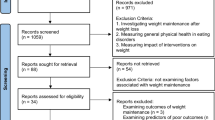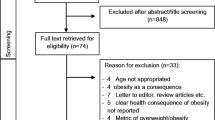Abstract
The majority of women gain more weight during pregnancy than what is recommended. Since gestational weight gain is related to short and long-term maternal health outcomes, it is important to identify women at greater risk of not adhering to guidelines. The objective of this study was to examine the relationship between body image and gestational weight gain. The Body Image Assessment for Obesity tool was used to measure ideal and current body sizes in 1,192 women participating in the Pregnancy, Infection and Nutrition Study. Descriptive and multivariable techniques were used to assess the effects of ideal body size and discrepancy score (current—ideal body sizes), which reflected the level of body dissatisfaction, on gestational weight gain. Women who preferred to be thinner had increased risk of excessive gain if they started the pregnancy at a BMI ≤26 kg/m2 but a decreased risk if they were overweight or obese. Comparing those who preferred thin body silhouettes to those who preferred average size silhouettes, low income women had increased risk of inadequate weight gain [RR = 1.76 (1.08, 2.88)] while those with lower education were at risk of excessive gain [RR = 1.11 (1.00, 1.22)]. Our results revealed that body image was associated with gestational weight gain but the relationship is complex. Identifying factors that affect whether certain women are at greater risk of gaining outside of guidelines may improve our ability to decrease pregnancy-related health problems.

Similar content being viewed by others
References
Ogden, C. L., Carroll, M. D., Curtin, L. R., McDowell, M. A., Tabak, C. J., & Flegal, K. M. (2006). Prevalence of overweight and obesity in the United States, 1999–2004. The Journal of the American Medical Association, 295(13), 1549–1555.
Flegal, K. M., Carroll, M. D., Ogden, C. L., & Johnson, C. L. (2002). Prevalence and trends in obesity among US adults, 1999–2000. The Journal of the American Medical Association, 288(14), 1723–1727.
Siega-Riz, A. M., Evenson, K. R., & Dole, N. (2004). Pregnancy-related weight gain–a link to obesity? Nutrition Reviews, 62, S105–S111.
Viswanathan, M., Siega-Riz, A. M., Moos, M., Deierlein, A., Mumford, S., Knaack, J., et al. (2008). Outcomes of maternal weight gain. Evidence report/technology assessment. Agency for Healthcare Research and Quality. Report No.: 168.
Nohr, E. A., Vaeth, M., Baker, J. L., Sorensen, T., Olsen, J., & Rasmussen, K. M. (2008). Combined associations of prepregnancy body mass index and gestational weight gain with the outcome of pregnancy. American Journal of Clinical Nutrition, 87(6), 1750–1759.
Gunderson, E. P., Abrams, B., & Selvin, S. (2000). The relative importance of gestational gain and maternal characteristics associated with the risk of becoming overweight after pregnancy. International Journal of Obesity & Related Metabolic Disorders, 24(12), 1660.
Rooney, B. L., Schauberger, C. W., & Mathiason, M. A. (2005). Impact of perinatal weight change on long-term obesity and obesity-related illnesses. Obstetrics and Gynecology, 106(6), 1349–1356.
Linne, Y., Dye, L., Barkeling, B., & Rossner, S. (2004). Long-term weight development in women: A 15-year follow-up of the effects of pregnancy. Obesity Research, 12(7), 1166–1178.
Linne, Y., Dye, L., Barkeling, B., & Rossner, S. (2003). Weight development over time in parous women–the SPAWN study–15 years follow-up. International Journal of Obesity and Related Metabolic Disorders, 27(12), 1516–1522.
National Research Council and Institute of Medicine. (2007). Influence of pregnancy weight on maternal and child health. Workshop report. Washington, DC: The National Academies Press.
Institute of Medicine. (1990). Nutrition during pregnancy; Part I, weight gain. Washington, DC: National Academy Press.
Grogan, S. (2006). Body image and health: Contemporary perspectives. Journal of Health Psychology, 11(4), 523–530.
Rucker, C. E., & Cash, T. F. (1992). Body images, body-size perceptions, and eating behaviors among African-American and white college women. The International Journal of Eating Disorders, 12(3), 291–299.
Garner, D. M. (2002). Body image and anorexia nervosa. In T. F. Cash & T. Pruzinsky (Eds.), Body image: A handbook of theory, research, & clinical practice (p. 295). New York: Guilford Press.
Schwartz, M. B., & Brownell, K. D. (2002). Obesity and body image. In T. F. Cash & T. Pruzinsky (Eds.), Body image: A handbook of theory, research, & clinical practice (p. 200). New York: Guilford Press.
Micali, N., Treasure, J., & Simonoff, E. (2007). Eating disorders symptoms in pregnancy: A longitudinal study of women with recent and past eating disorders and obesity. Journal of Psychosomatic Research, 63(3), 297–303.
Lovejoy, M. (2001). Disturbances in the social body: Differences in body image and eating problems among African American and white women. Gender & Society, 15(2), 239–261.
Perez, M., & Joiner, T. E., Jr. (2003). Body image dissatisfaction and disordered eating in black and white women. The International Journal of Eating Disorders, 33(3), 342–350.
Smith, D. E., Thompson, J. K., Raczynski, J. M., & Hilner, J. E. (1999). Body image among men and women in a biracial cohort: The CARDIA study. The International Journal of Eating Disorders, 25(1), 71–82.
Herman, C. P., & Polivy, J. (1980). Restrained eating. In A. J. Stunkard (Ed.), Obesity (pp. 208–225). Philadelphia: Saunders.
Palmer, J. L., Jennings, G. E., & Massey, L. (1985). Development of an assessment form: Attitude toward weight gain during pregnancy. Journal of the American Dietetic Association, 85(8), 946–949.
Proctor, B. D., Dalaker, J. (2001). Poverty in the United States: 2001. US Bureau of the Census, Current population reports. Washington, DC: US Government Printing Office; 2001. Report No.: Series P60-219.
Greenland, S., Pearl, J., & Robins, J. M. (1999). Causal diagrams for epidemiologic research. Epidemiology, 10(1), 37–48.
Bodnar, L. M., Siega-Riz, A. M., & Cogswell, M. E. (2004). High prepregnancy BMI increases the risk of postpartum anemia. Obesity Research, 12(6), 941–948.
Siega-Riz, A. M., Adair, L. S., & Hobel, C. J. (1994). Institute of medicine maternal weight gain recommendations and pregnancy outcome in a predominantly Hispanic population. Obstetrics and Gynecology, 84(4), 565–573.
Vahratian, A., Siega-Riz, A. M., Savitz, D. A., & Zhang, J. (2005). Maternal pre-pregnancy overweight and obesity and the risk of cesarean delivery in nulliparous women. Annals of Epidemiology, 15(7), 467–474.
Mumford, S. L., Siega-Riz, A. M., Herring, A., & Evenson, K. R. (2008). Dietary restraint and gestational weight gain. Journal of the American Dietetic Association, 108(10), 1646–1653.
Williamson, D. A., Womble, L. G., Zucker, N. L., Reas, D. L., White, M. A., Blouin, D. C., et al. (2000). Body image assessment for obesity (BIA-O): Development of a new procedure. International Journal of Obesity and Related Metabolic Disorders, 24(10), 1326–1332.
Rothman, K. J., & Greenland, S. (1998). Modern epidemiology (2nd ed.). Philadelphia, PA: Lippincott–Raven.
Zou, G. (2004). A modified Poisson regression approach to prospective studies with binary data. American Journal of Epidemiology, 159(7), 702–706.
Skouteris, H., Carr, R., Wertheim, E. H., Paxton, S. J., & Duncombe, D. (2005). A prospective study of factors that lead to body dissatisfaction during pregnancy. Body Image, 2(4), 347–361.
Duncombe, D., Wertheim, E. H., Skouteris, H., Paxton, S. J., & Kelly, L. (2008). How well do women adapt to changes in their body size and shape across the course of pregnancy? Journal of Health Psychology, 13(4), 503–515.
Ferrari, R. M., Siega-Riz, A. M., Melvin, C. L. (2008). Influence of provider advice and maternal attitudes on weight change and physical activity during pregnancy and postpartum [dissertation]. Chapel Hill, NC: University of North Carolina at Chapel Hill.
Laraia, B. A., Siega-Riz, A. M., Dole, N., & London, E. (2009). Pregravid weight is associated with prior dietary restraint and psychosocial factors during pregnancy. Obesity (Silver Spring), 17(3), 550–558.
Neff, L. J., Sargent, R. G., McKeown, R. E., Jackson, K. L., & Valois, R. F. (1997). Black-white differences in body size perceptions and weight management practices among adolescent females. Journal of Adolescent Health, 20(6), 459–465.
Mvo, Z., Dick, J., & Steyn, K. (1999). Perceptions of overweight African women about acceptable body size of women and children. Curationis, 22(2), 27–31.
Must, A., Phillips, S. M., Stunkard, A. J., & Naumova, E. N. (2002). Expert opinion on body mass index percentiles for figure drawings at menarche. International Journal of Obesity and Related Metabolic Disorders, 26(6), 876–879.
Acknowledgments
This study received support from the National Institute of Child Health and Human Development, National Institutes of Health (HD37584, HD39373), the National Institute of Diabetes and Digestive and Kidney Diseases (DK61981, DK56350, RR00046), and the Carolina Population Center.
Conflict of interest statements
No conflicts of interest exist.
Author information
Authors and Affiliations
Corresponding author
Rights and permissions
About this article
Cite this article
Mehta, U.J., Siega-Riz, A.M. & Herring, A.H. Effect of Body Image on Pregnancy Weight Gain. Matern Child Health J 15, 324–332 (2011). https://doi.org/10.1007/s10995-010-0578-7
Published:
Issue Date:
DOI: https://doi.org/10.1007/s10995-010-0578-7




